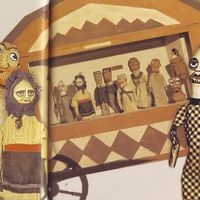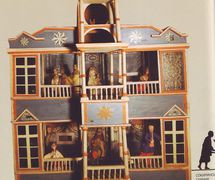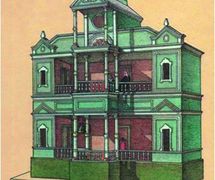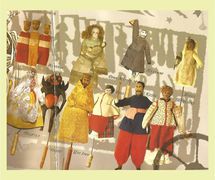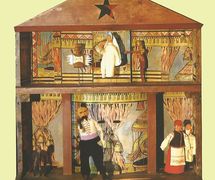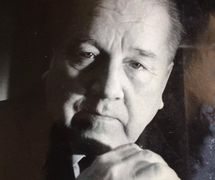Ukraine (Ukrainian: Україна, transl. Ukrayina or Ukraina), located in Eastern Europe, borders Russia, Belarus, Poland, Slovakia, Hungary, Romania, and Moldova. The region of modern Ukraine has a very ancient history; it was a key centre of East Slavic culture during the Middle Ages. The dominant religion is Eastern Orthodoxy, which has had a profound influence on Ukrainian music, arts and architecture.
The traditions of Ukrainian puppet theatre have their roots in Slav liturgy, whose pagan rites and performances employed various masks and dolls. Between the 16th and 18th centuries, the vertep (“grotto” or “cave” in the old Slavonic language) with its depiction of the Nativity became a very popular entertainment. The construction of the crib show and the dramatic sequence of events were almost identical to those of the Polish szopka (see Poland) or the Belarusian batleyka (see Belarus). Each was presented in a portable cabinet or cupboard in the form of a little house with a cross mounted on the roof. Beneath this, before the show, a candle was placed behind a window, signifying a star. When opened, the cabinet revealed two levels or storeys at the back of which gaps or grooves allowed the manipulation of the small puppets, attached to rods or hands. The puppets were normally made of wood and were capable of only minimal movement.
The upper level of the “house” was dedicated to the Nativity story, showing angels and the Three Wise Men with their gifts. After this the action was in the lower level where the Massacre of the Innocents by Herod could be seen before a popular comedy, Zaporozhets (an unruly Zaporozhian Cossack anti-hero), more in the style of other European street shows.
The vertep is considered one of the more mysterious forms of traditional theatre, not only because it retains an archaic representation of the Universe, but because it mixes two forms of contemporary theatre, the sacred and the (extremely) profane.
The first documentary evidence of the vertep is to be found in the 1533 chronicles of the theological school of Lvov (Lviv) that tell of the activities of the itinerant students, or bursa. In fact, it was these bursa students who began to promote the vertep in their travels from village to village – you may find a description in Viy (1835), a short story by Nikolai Gogol.
In 1770, one of the oldest known vertep booths, from the Cossack village of Sokyryntsi (Poltava province), was acquired by a landowner, Grigory Galagan. Its original figures are exhibited in the Puppet Museum of the Sergei Obraztsov Central Puppet Theatre (see Gosudarstvenny Akademichesky Tsentralny Teatr Kukol imeni S.V. Obraztsova) in Moscow. In addition there is a vertep festival in Moscow initiated by Viktor Novatsky (1929-2003) and Irina Uvarova in 1995.
Professionalization
Alongside these popular forms, there existed in the Ukraine a more professional type of puppet theatre. From the end of the 18th century European puppet players (Italian, German and French) arrived with their farces and comedies, usually performed with string puppets. To these were added, in the 19th century, shows by automata and other mechanical theatres.
At the beginning of the 20th century personalities of the theatre world and fine artists became interested in popular traditions. In 1905, the composer and musicologist Nikola Lysenko (1842-1912) gave a performance based on the vertep in his music and theatre studio in Kiev (Ukrainina: Kyiv). Aleksander Stepanovich, known as Les Kurbas (1887-1942), was also attracted by the tradition and, in 1916, founded the company “Theatre of the Young”. One of its first shows was Vertep, a landmark in Ukrainian theatre. It was performed in a magnified staging in which, on the upper level, actors imitated the mechanical movements of puppets, while on the lower level the comic element was played in the usual theatrical style.
The Bi-Ve-Mar company, founded in Kharkov (Kharkiv) by two fine-artists, Pyotr Dzhunkovsky and Vera Belorusova, was also grounded in tradition. Influenced by Czech puppeteers, the two artists dreamt of an experimental theatre which would combine several techniques: string puppets, shadows and ventriloquism – hence the name of the company: Bi, first syllable of the name of one of their puppets Bi-Ba-Bo; Ve for ventrolka or ventriloquist; and Mar for marionette. Their first show was The Nightingale and the Emperor (1922) based on the Hans Christian Andersen fairy tale. Following its success they joined the Russian company of Nina Simonovitch-Efimova and Ivan Efimov who had been (in part) their tutors.
The Soviet Era
In contrast to the other republics which formed the Soviet Union, the Ukraine remained, at least in its theatre activity, moderately independent, even under the dominance of Russia. Thus “agit-prop” appeared in the Ukraine during the 1920s, centred on the model of the vertep. One initiator of this movement was Oleg Kisil who, in 1918, wrote a book and several articles on the vertep, its professionalization and adaptation of modern texts. His ideas were realized in The Revolutionary Vertep, staged in Mezhgorye by the students and tutors of the art school directed by Pavel Gorbenko.
In the 1930s and 40s, the Ukrainian theatre was greatly influenced by the ideas and productions of Sergei Obraztsov. Between 1934 and 1940, almost thirty puppet theatres, that is to say one in almost every regional centre, aimed to imitate his work, using as he did glove or rod puppets and following the same style of set designs and performance. By the end of World War II only a dozen of these theatres remained. The post-war shows and the first years of the 1950s moved towards realism, using miniaturized scenery and characters.
Viktor Andreevich Afanasiev played a decisive role in re-orienting Ukrainian art towards the puppet. In 1952, appointed Director of the Kharkov Kharkiv Puppet Theatre, which under him became the best of the national companies, he effectively created a generation of professional puppeteers who became known internationally: Valery Volkhovsky, Leonid Khait, Sergei Efremov, Viktor Shraiman, Yuri Friedman as well as actors such as Eleonora Smirnova, Charles Phoerberg and Evgeny Terletski.
The 1960s were notable for the birth of professional Ukrainian organizations. The puppetry section of the Ukrainian Theatrical Society in Kyiv successfully organized seminars, conferences and festivals. The repertoire was naturally turning towards Ukrainian writers such as Grigory Usach, Vladimir Orlov and Pyotr Vysotsky. The plays of Yefim Chepovetsky (Gee Whiz, Mytsik!, I’m a Chicken, You’re a Chicken!, and The Topsy-Turvy Fairy Tale) became especially popular.
Puppet departments were established in various art schools of higher education (in the Kyiv theatre under the direction of Aleksander Solomarsky in 1969; at the Kharkov Kharkiv Institute of Art under Viktor Afanasiev in 1969), and their graduates soon became the leaders of several companies.
In the 1970s and 1980s, Sergey Efremov, Yuri Sikalo (of the Kyiv Republican Puppet Theatre), Boris Azarov (of the Crimean Puppet Theatre based in Simferopol), Valery Bugayov (of the Dniepropetrovsk Puppet Theatre) Leonid Popov (of the Khmelnitski Puppet Theatre) were considered the élite among the puppet theatres of the Ukraine.
In 1975, a State Puppet Theatre was established at Lutsk (Volyn region in the north-west) under the direction of Danila Poshtaruk; from 1983 it became the home of Ukrainian puppet festivals, to which, since 1992, a festival of vertep has been added.
Post-Soviet Tendencies
The break-up of the Soviet Union placed the Ukrainian puppet theatre, like the theatres in the other republics, in a difficult situation. Nevertheless most of the state and municipal companies continued their work, now joined by a number of private groups. The Kyiv theatre became a private enterprise, founded by director, puppet maker and scenographer Mikhail Yaremchuk in 1989. He started with children’s shows (There Lived an Old Man, There was a Rolling Bag, Who Can Wake the Sun?, Little Red Riding Hood) whose technical and dramatic excellence appealed equally to adults. Then the company developed with shows such as Anton Chekhov’s The Cherry Orchard, and The House That Swift Built, a play by Grigory Gorin. All Yaremchuk’s productions, which he produced together with Tatyana Torbenko, the designer-conceptualizer of the puppetry, are in some way a variation on creation myths: the puppeteers are visible and invent a whole scenic universe. The company has played throughout Europe.
Bibliography
- Fedas, I. E. Ukrainskiy narodniy vertep (v issledovaniyakh 19-20 vekov) [The Ukrainian Folk Vertep (Research of the Nineteenth and Twentieth Centuries)]. Kiev, 1987. (In Russian)
- Franko, I. “Do istorii Ukrainskogo vertepu 18 veku” [History of the Eighteenth Century Ukrainian Vertep]. Zapiski Naukovogo Tovaristva [Proceedings of the Scientific Association]. Vols. 71-72, 1906. (In Ukrainian)
- Goldovsky, Boris, and S. A. Smelyanskaya. Teatr kukol Ukrainiy [The Ukrainian Puppet Theatre]. San Francisco: International Press, 1988. (In Russian)









